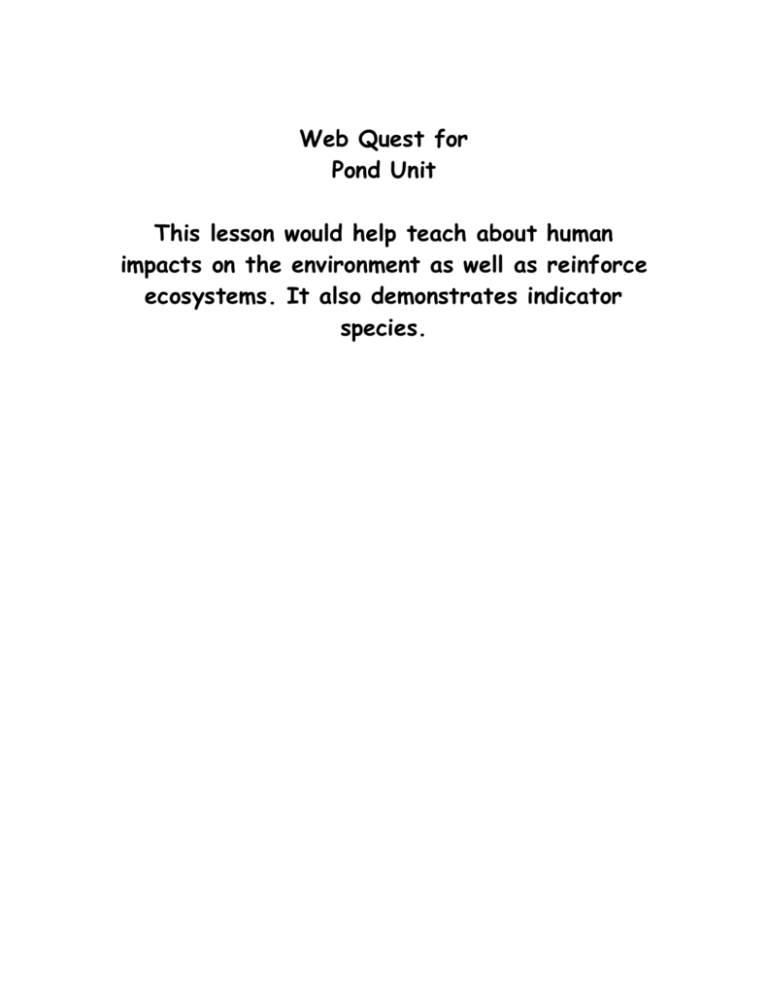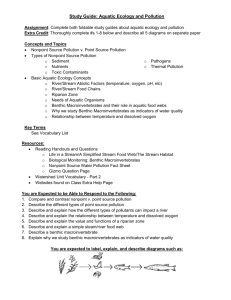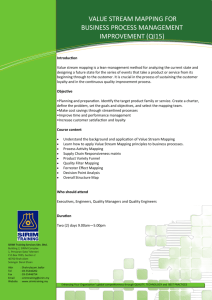Web Quest for Pond Life
advertisement

Web Quest for Pond Unit This lesson would help teach about human impacts on the environment as well as reinforce ecosystems. It also demonstrates indicator species. Human Impacts & Virtual Stream Study For this Web Quest, you will be a scientist exploring the health of a stream. Have humans impacted it? To begin, you need to get some background on how bodies of water are impacted, and how you can measure the health of a stream. At the end you will be given data from a local stream. You will need to identify the creatures and determine if the stream is impacted or not, and what might have impacted it. Instructions: 1. Use the links below to answer the questions on your sheet. 2. When you are done answering the questions, show the teacher and get the information on a local stream. 3. When you get the data on the stream, use your knowledge and the links to macroinvertebrates to identify the macros found in your stream, and then determine the health of your stream. Basics: http://dnr.metrokc.gov/wlr/waterres/Bugs/indicator.htm http://www.cwmb.sa.gov.au/kwc/programs/a_bugs_life/1.htm http://www.bgsd.k12.wa.us/hml/jr_cam/macros/macro_id-htm/slide_02.htm http://www.epa.gov/OWOW/NPS/kids/BUGTHTR.HTM Why study Macroinvertebrates? http://www.bgsd.k12.wa.us/hml/jr_cam/macros/macro_id-htm/slide_03.htm http://techalive.mtu.edu/meec/module05/BiologicalCharacteristics.htm Stream health: http://techalive.mtu.edu/meec/module05/ImportanceofHealthyStreams.ht m http://techalive.mtu.edu/meec/module05/LetsTakeaStreamTour.htm Tolerance to pollution in macros http://techalive.mtu.edu/meec/module05/WhatDoWeExpecttoSee.htm Identification: http://www.naturegrid.org.uk/pondexplorer/key.html http://www.microscopy-uk.org.uk/index.html?http://www.microscopyuk.org.uk/pond/insects.html Virtual pond dip http://www.naturegrid.org.uk/pondexplorer/pond3.html Macros to ID: http://www.bgsd.k12.wa.us/hml/jr_cam/macros/macros_set_a/macros_set_ a.html http://www.bgsd.k12.wa.us/hml/jr_cam/macros/macros_set_b/macros_set_ b.html Non-point source pollution: http://www.epa.gov/owow/nps/qa.html Non-point and impacted stream quiz http://www.watersheds.org/kids/WaterQuiz.htm Questions: 1. What is nonpoint source pollution? Give 5 examples of how humans can impact a stream or river through nonpoint source pollution. 2. Why do we care if our streams are healthy? 3. What are 3 different things to consider when looking at the health of a stream? (http://techalive.mtu.edu/meec/module05/LetsTakeaSt reamTour.htm) 4. What is a macroinvertebrate? Give 5 examples. 5. What does “macro” mean? 6. What is an invertebrate? 7. How do macroinvertebrates tell you about the health of a stream? How is diversity important? 8. Why do we use macroinvertebrates? 9. What are the 3 categories of pollution tolerance that we put macroinvertebrates into? 10. Which macros cannot tolerate any pollution? (They are pollution sensitive and indicate that a stream is healthy). Name 6. 11. Name 6 macros that are somewhat pollution sensitive. 12. Name 4 macros that are tolerant to pollution. 13. Identify the macro below. Click on it to bring you to a website to identify it. EVALUATION: 14. Go to the following link and read the first page. Go to the next page using the arrows at the top and follow the directions. You will need to identify each macroinvertebrate. http://techalive.mtu.edu/meec/module05/BiologicalInstructions.htm 15. What was the exact stream quality score that you got for each stream. List it below. Moose Creek: ________ Deer Creek: ________ Bear Creek: ________ 16. What was the healthiest stream? Why? 17. Which stream has been impacted the most? 17. On the back of this sheet, come up with a scenario (what is going on around the creek) that could contribute to the poor water quality of the creek that you determined was the most impacted. What is impacting it? (It doesn’t tell you in the website- you will need to make something up based on your knowledge of non-point source pollution and what might affect the water quality.) Conclusion Humans constantly have an impact on their surroundings. Water is one of the things we can’t live without, so it is important that we know what affects our drinking water, so we can protect it. Macroinvertebrates are one way we can check to see if our waters are impacted, like you did in the above activity.







